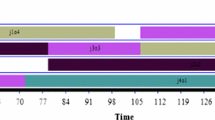Abstract
This paper deals with the balanced allocation of customers to multiple third party logistics warehouses. The allocation problem generally deals with clustering of customers so as to achieve minimum total resource viz. cost or time. But the real challenge arises when it is required to strike a balance between the allocation while also minimizing the total cost or time. Since the problem develops to be non-deterministic polynomial-time hard, the paper uses simulated annealing approach to solve the problem. The balanced solution is achieved by using the min–max function. The effectiveness of the new algorithm is presented through simulation of large sets of problems.
Similar content being viewed by others
References
Aikens CH (1985) Facility location models for distribution planning. Eur J Oper Res 22:263–279
Chan FTS, Kumar N (2009) Effective allocation of customers to distribution centres: a multiple ant colony optimization approach. Robotics Comput-Intgr Manuf 25(1):1–12
Current JR, Min H, Schilling DA (1990) Multiobjective analysis of location decisions. Eur J Oper Res 49(12):295–307
Geoffrion AM, Morris JG, Webster ST (1995) Distribution system design. In: Drezner Z (ed) Facility location: a survey of application and methods. Springer, New York, pp 81–198
Huang B and Liu N (2004) Bilevel programming approach to optimizing a logistic distribution network with balancing requirements. Transportation Research Record: Journal of the Transportation Research Board, No. 1894, TRB. National Research Council, Washington, D.C., pp 188–197
Kirkpatrick S, Gelatt CD, Vecchi MP (1983) Optimization by simulated annealing. Science 220:671–680
Maltz AB, Ellram LM (2000) Selling inbound logistics services: understanding the buyer’s perspective. J Bus Logist 21(2):69–88
Menon MK, McGinnis MA, Ackerman KB (1998) Selection criteria for providers of third-party logistics services: an exploratory study. J Bus Logist 19(1):121–137
Min H, Zhou G, Gen M, Cao Z (2005) A genetic algorithm approach to the balanced allocation of customers to multiple warehouses with varying capacities. Int J Logistics: Res & Appl 8(3):181–192
Syam SS (2002) A model and methodologies for the location problem with logistical components. Comput Oper Res 29:1173–1193
Wilson AG (1986) Industrial location models: a review and an integrating framework. Environ Plann A 18:175–205
Yamada T, Takahashi S, Kataoka H (1996) A heuristic algorithm for the mini–max spanning forest problem. Eur J Oper Res 91:565–572
Yildiz AR (2008) Hybrid Taguchi-harmony search algorithm for solving engineering optimization problems. Int J Ind Eng Theory, Appl Pract 15(3):286–293
Yildiz AR (2008) Optimal structural design of vehicle components using topology design and optimization. Mater Test 50(4):224–228
Yildiz AR (2009) A new design optimization framework based on immune algorithm and Taguchi method. Comput Ind 60(8):613–620
Yildiz AR (2009) A novel hybrid immune algorithm for global optimization in design and manufacturing. Robotics Comput-Integr Manuf 25(2):261–270
Yildiz AR (2009) A novel particle swarm optimization approach for product design and manufacturing. Int J Adv Manuf Technol 40(5–6):617–628
Yildiz AR (2009) An effective hybrid immune-hill climbing optimization approach for solving design and manufacturing optimization problems in industry. J Mater Process Technol 50(4):224–228
Yildiz AR (2009) Hybrid immune-simulated annealing algorithm for optimal design and manufacturing. Int J Mater Prod Technol 34(3):217–226
Yildiz AR, Kaya N, Alankus OB, Ozturk F (2004) Optimal design of vehicle components using topology design and optimization. Int J Veh Des 34(4):387–398
Yildiz AR, Ozturk F (2006) Hybrid enhanced genetic algorithm to select optimal machining parameters in turning operation. J Eng Manuf 220(12):2041–2053
Yildiz AR, Ozturk N, Kaya N, Ozturk F (2003) Integrated optimal topology design and shape optimization using neural networks. Struct Multidiscip Optim 25(4):251–260
Yildiz AR, Ozturk N, Kaya N, Ozturk F (2007) Hybrid multi-objective shape design optimization using Taguchi’s method and genetic algorithm. Struct Multidiscip Optim 34(4):277–365
Yildiz AR, Saitou K (2011) Topology synthesis of multicomponent structural assemblies in continuum domains. ASME J Mech Des 133:1
Yildiz AR, Solanki KN (2011) Multi-objective optimization of vehicle crashworthiness using a new particle swarm based approach. Int J Adv Manuf Tech. doi:10.1007/s00170-011-3496-y
Zhou G, Min H, Gen M (2002) The balanced allocation of customers to multiple distribution centers in the supply chain network: a genetic algorithm approach. Comput Ind Eng 43:251–261
Zhou G, Min H, Gen M (2003) A genetic algorithm approach to the bi-criteria allocation of customers to warehouses. Int J Prod Econ 86:35–45
Author information
Authors and Affiliations
Corresponding author
Rights and permissions
About this article
Cite this article
Rajesh, R., Pugazhendhi, S. & Ganesh, K. Simulated annealing algorithm for balanced allocation problem. Int J Adv Manuf Technol 61, 431–440 (2012). https://doi.org/10.1007/s00170-011-3725-4
Received:
Accepted:
Published:
Issue Date:
DOI: https://doi.org/10.1007/s00170-011-3725-4




